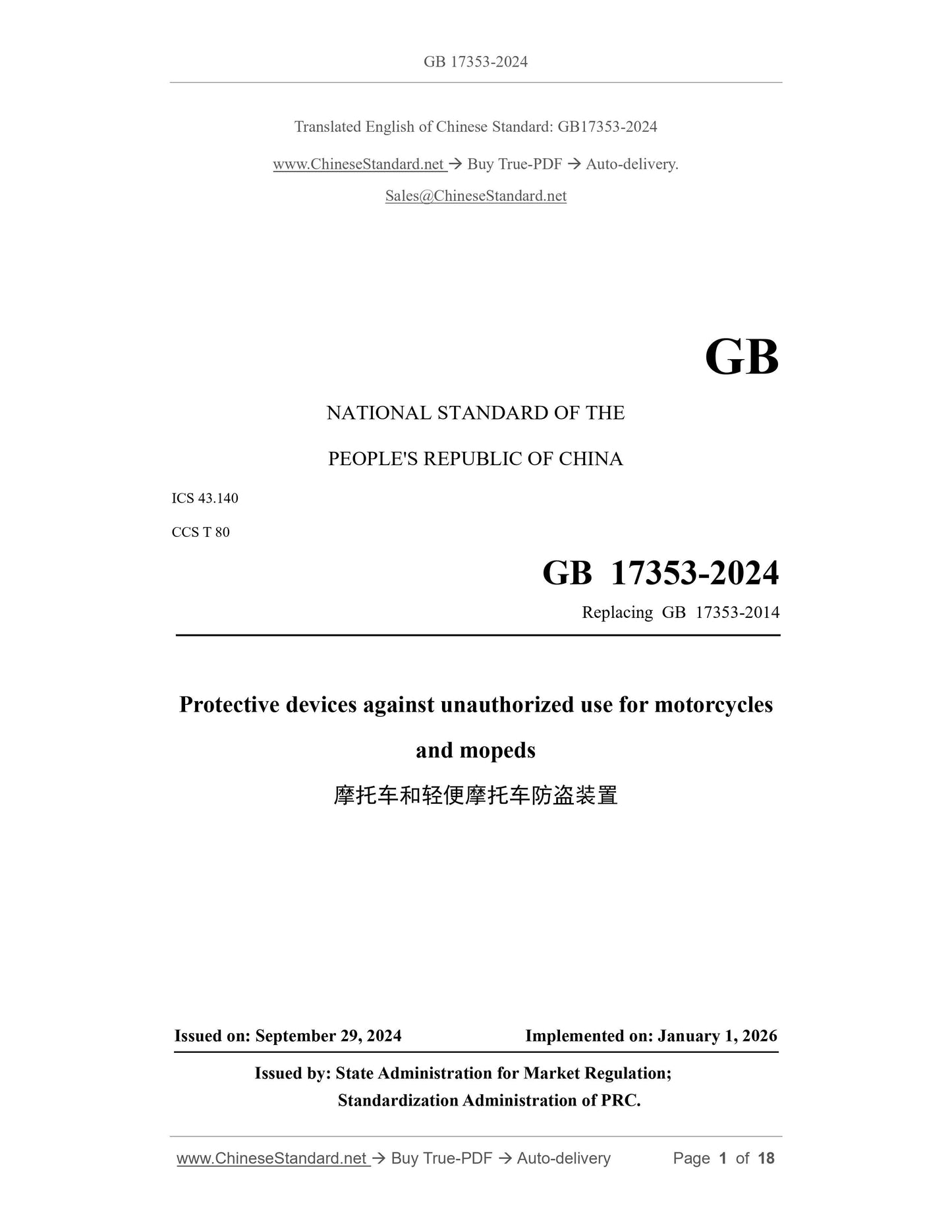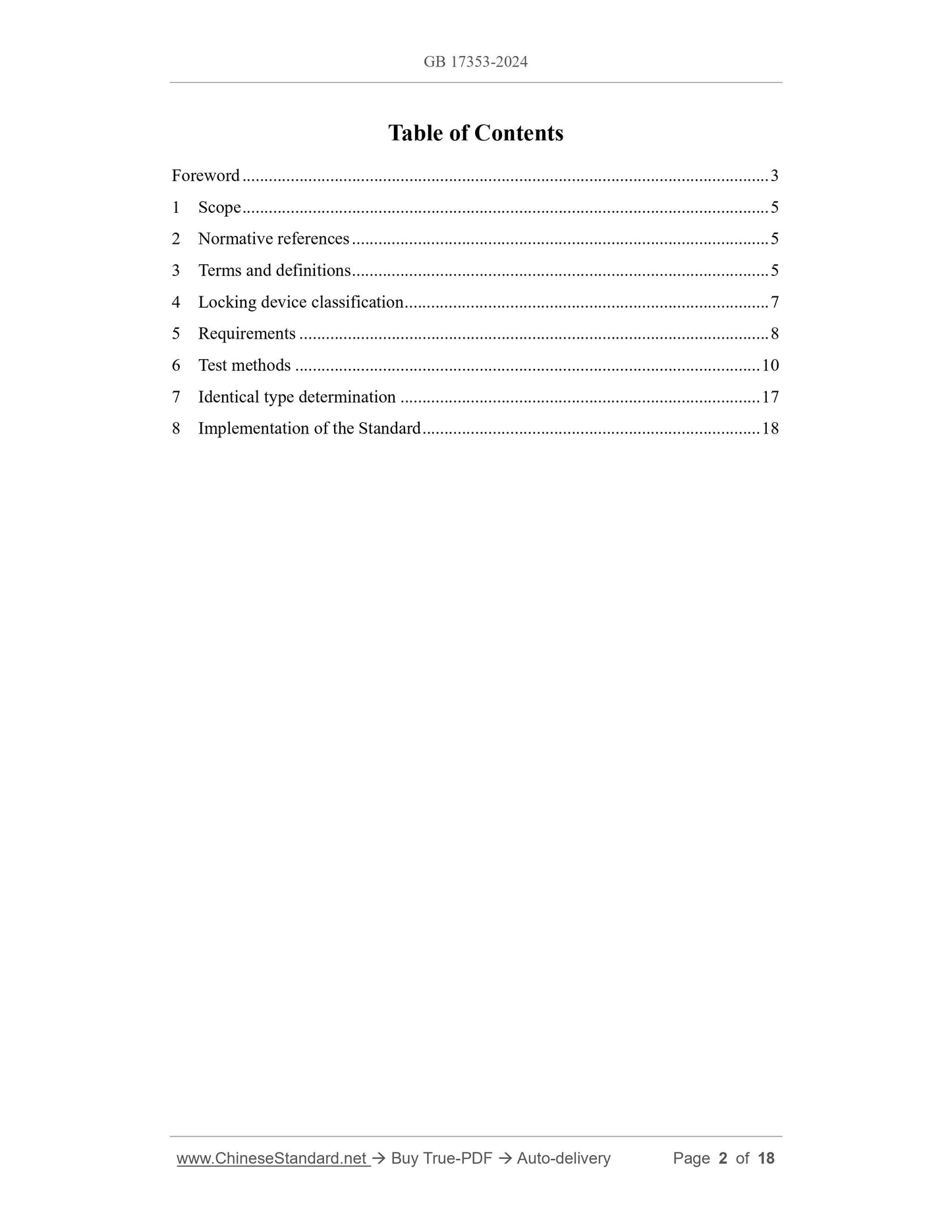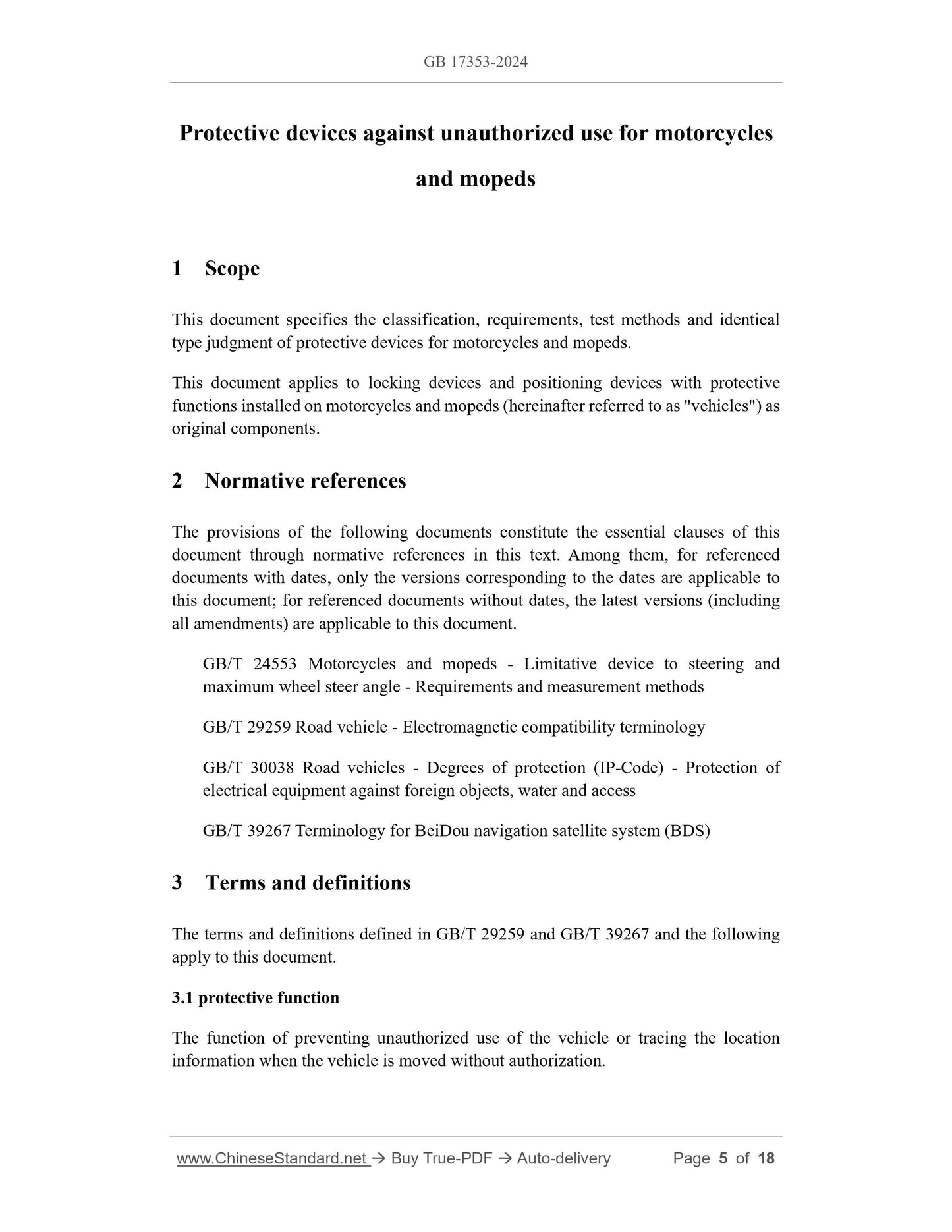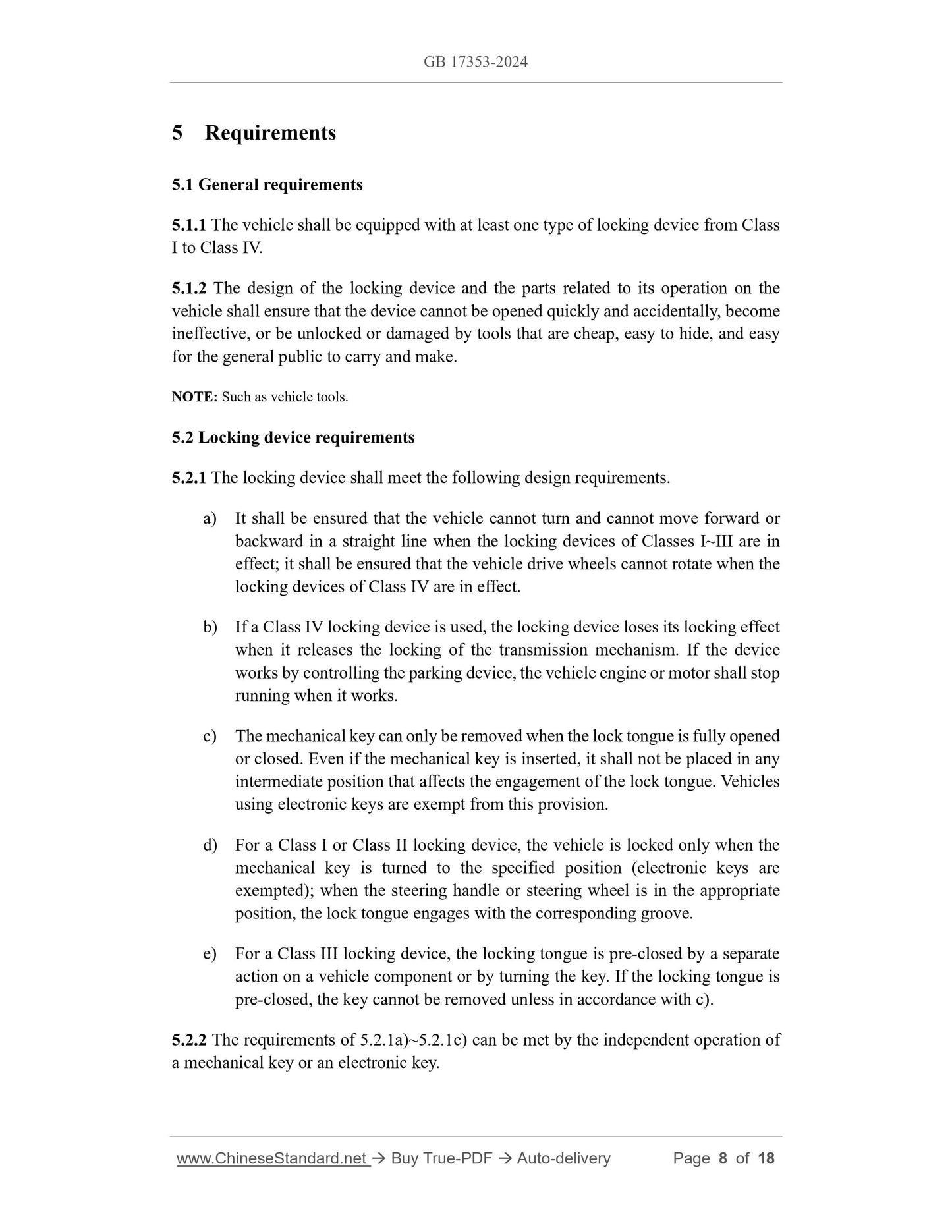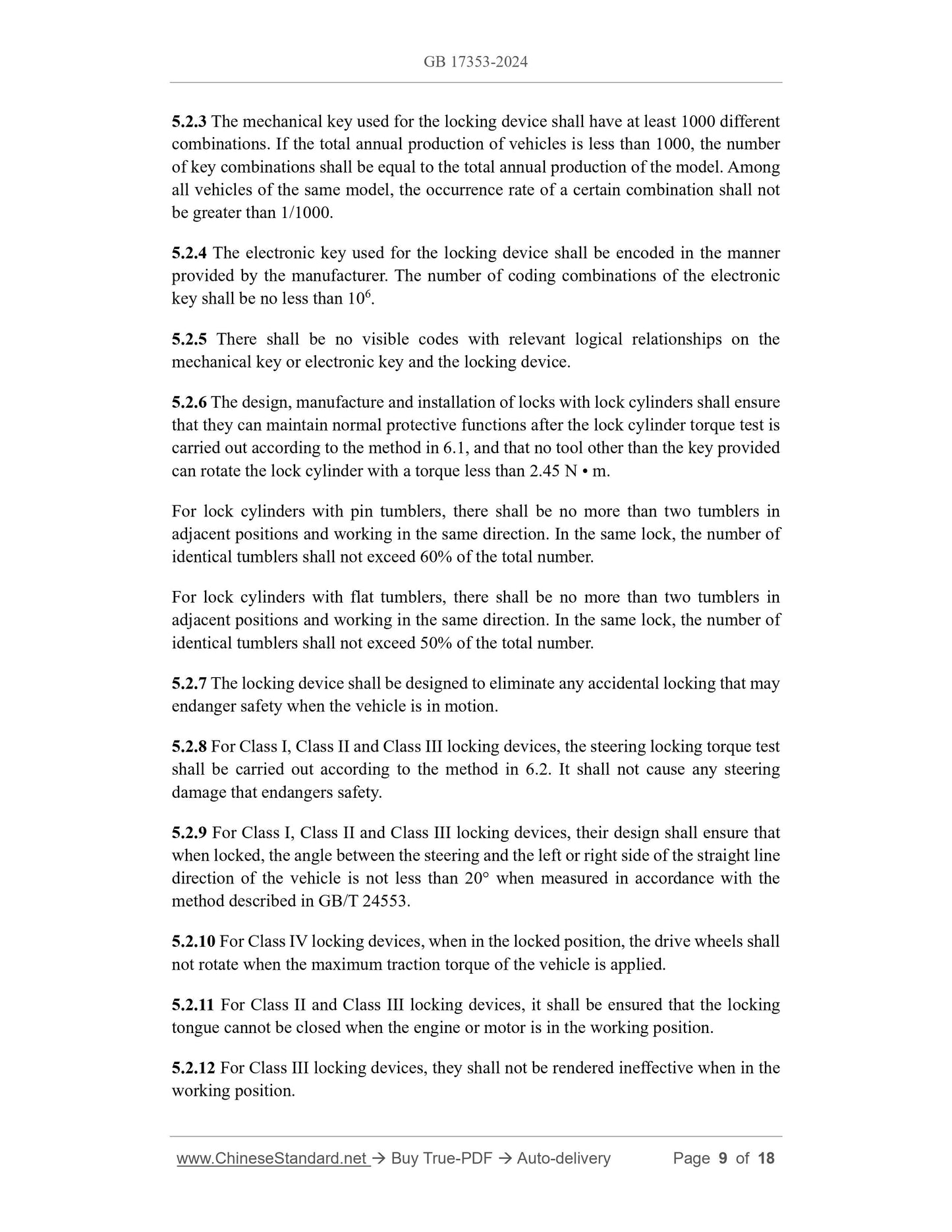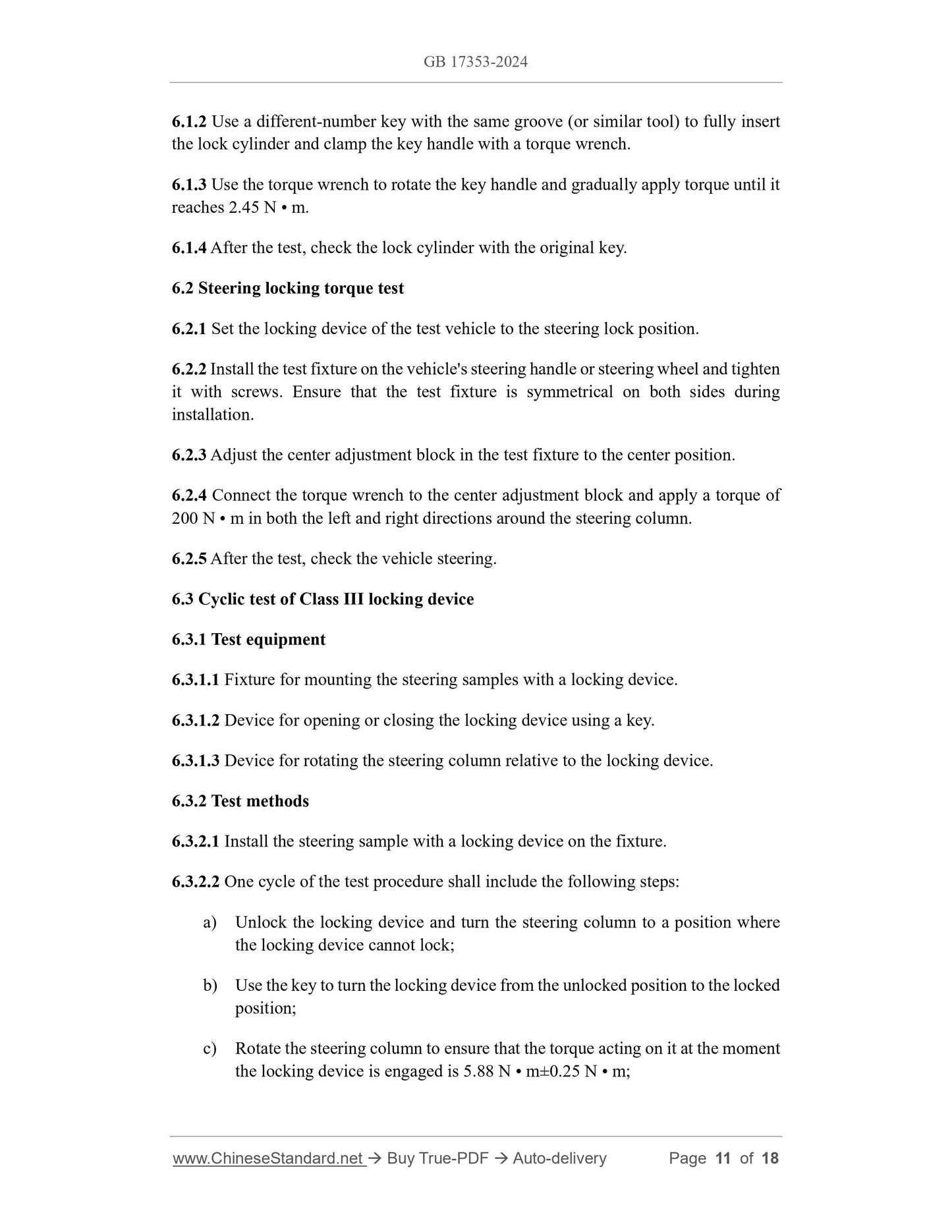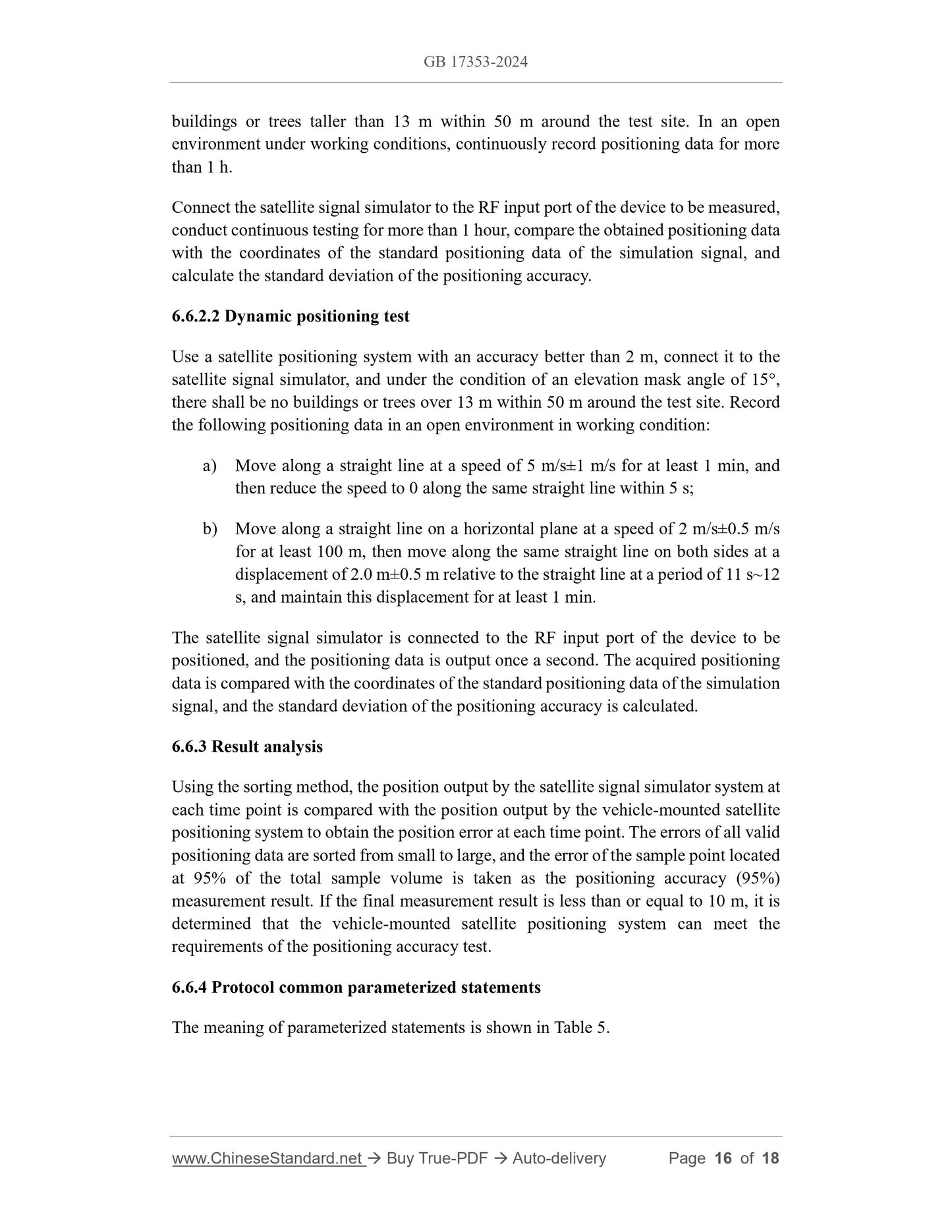1
/
of
7
PayPal, credit cards. Download editable-PDF and invoice in 1 second!
GB 17353-2024 English PDF
GB 17353-2024 English PDF
Regular price
$200.00 USD
Regular price
Sale price
$200.00 USD
Unit price
/
per
Shipping calculated at checkout.
Couldn't load pickup availability
Delivery: 3 seconds. Download true-PDF + Invoice.
Get QUOTATION in 1-minute: Click GB 17353-2024
Historical versions: GB 17353-2024
Preview True-PDF (Reload/Scroll if blank)
GB 17353-2024: Protective devices against unauthorized use for motorcycles and mopeds
GB 17353-2024
GB
NATIONAL STANDARD OF THE
PEOPLE'S REPUBLIC OF CHINA
ICS 43.140
CCS T 80
Replacing GB 17353-2014
Protective devices against unauthorized use for motorcycles
and mopeds
ISSUED ON: SEPTEMBER 29, 2024
IMPLEMENTED ON: JANUARY 1, 2026
Issued by: State Administration for Market Regulation;
Standardization Administration of PRC.
Table of Contents
Foreword ... 3
1 Scope ... 5
2 Normative references ... 5
3 Terms and definitions ... 5
4 Locking device classification ... 7
5 Requirements ... 8
6 Test methods ... 10
7 Identical type determination ... 17
8 Implementation of the Standard ... 18
Protective devices against unauthorized use for motorcycles
and mopeds
1 Scope
This document specifies the classification, requirements, test methods and identical
type judgment of protective devices for motorcycles and mopeds.
This document applies to locking devices and positioning devices with protective
functions installed on motorcycles and mopeds (hereinafter referred to as "vehicles") as
original components.
2 Normative references
The provisions of the following documents constitute the essential clauses of this
document through normative references in this text. Among them, for referenced
documents with dates, only the versions corresponding to the dates are applicable to
this document; for referenced documents without dates, the latest versions (including
all amendments) are applicable to this document.
GB/T 24553 Motorcycles and mopeds - Limitative device to steering and
maximum wheel steer angle - Requirements and measurement methods
GB/T 29259 Road vehicle - Electromagnetic compatibility terminology
GB/T 30038 Road vehicles - Degrees of protection (IP-Code) - Protection of
electrical equipment against foreign objects, water and access
GB/T 39267 Terminology for BeiDou navigation satellite system (BDS)
3 Terms and definitions
The terms and definitions defined in GB/T 29259 and GB/T 39267 and the following
apply to this document.
3.1 protective function
The function of preventing unauthorized use of the vehicle or tracing the location
information when the vehicle is moved without authorization.
5 Requirements
5.1 General requirements
5.1.1 The vehicle shall be equipped with at least one type of locking device from Class
I to Class IV.
5.1.2 The design of the locking device and the parts related to its operation on the
vehicle shall ensure that the device cannot be opened quickly and accidentally, become
ineffective, or be unlocked or damaged by tools that are cheap, easy to hide, and easy
for the general public to carry and make.
NOTE: Such as vehicle tools.
5.2 Locking device requirements
5.2.1 The locking device shall meet the following design requirements.
a) It shall be ensured that the vehicle cannot turn and cannot move forward or
backward in a straight line when the locking devices of Classes I~III are in
effect; it shall be ensured that the vehicle drive wheels cannot rotate when the
locking devices of Class IV are in effect.
b) If a Class IV locking device is used, the locking device loses its locking effect
when it releases the locking of the transmission mechanism. If the device
works by controlling the parking device, the vehicle engine or motor shall stop
running when it works.
c) The mechanical key can only be removed when the lock tongue is fully opened
or closed. Even if the mechanical key is inserted, it shall not be placed in any
intermediate position that affects the engagement of the lock tongue. Vehicles
using electronic keys are exempt from this provision.
d) For a Class I or Class II locking device, the vehicle is locked only when the
mechanical key is turned to the specified position (electronic keys are
exempted); when the steering handle or steering wheel is in the appropriate
position, the lock tongue engages with the corresponding groove.
e) For a Class III locking device, the locking tongue is pre-closed by a separate
action on a vehicle component or by turning the key. If the locking tongue is
pre-closed, the key cannot be removed unless in accordance with c).
5.2.2 The requirements of 5.2.1a)~5.2.1c) can be met by the independent operation of
a mechanical key or an electronic key.
5.2.3 The mechanical key used for the locking device shall have at least 1000 different
combinations. If the total annual production of vehicles is less than 1000, the number
of key combinations shall be equal to the total annual production of the model. Among
all vehicles of the same model, the occurrence rate of a certain combination shall not
be greater than 1/1000.
5.2.4 The electronic key used for the locking device shall be encoded in the manner
provided by the manufacturer. The number of coding combinations of the electronic
key shall be no less than 106.
5.2.5 There shall be no visible codes with relevant logical relationships on the
mechanical key or electronic key and the locking device.
5.2.6 The design, manufacture and installation of locks with lock cylinders shall ensure
that they can maintain normal protective functions after the lock cylinder torque test is
carried out according to the method in 6.1, and that no tool other than the key provided
can rotate the lock cylinder with a torque less than 2.45 N • m.
For lock cylinders with pin tumblers, there shall be no more than two tumblers in
adjacent positions and working in the same direction. In the same lock, the number of
identical tumblers shall not exceed 60% of the total number.
For lock cylinders with flat tumblers, there shall be no more than two tumblers in
adjacent positions and working in the same direction. In the same lock, the number of
identical tumblers shall not exceed 50% of the total number.
5.2.7 The locking device shall be designed to eliminate any accidental locking that may
endanger safety when the vehicle is in motion.
5.2.8 For Class I, Class II and Class III locking devices, the steering locking torque test
shall be carried out according to the method in 6.2. It shall not cause any steering
damage that endangers safety.
5.2.9 For Class I, Class II and Class III locking devices, their design shall ensure that
when locked, the angle between the steering and the left or right side of the straight line
direction of the vehicle is not less than 20° when measured in accordance with the
method described in GB/T 24553.
5.2.10 For Class IV locking devices, when in the locked position, the drive wheels shall
not rotate when the maximum traction torque of the vehicle is applied.
5.2.11 For Class II and Class III locking devices, it shall be ensured that the locking
tongue cannot be closed when the engine or motor is in the working position.
5.2.12 For Class III locking devices, they shall not be rendered ineffective when in the
working position.
6.1.2 Use a different-number key with the same groove (or similar tool) to fully insert
the lock cylinder and clamp the key handle with a torque wrench.
6.1.3 Use the torque wrench to rotate the key handle and gradually apply torque until it
reaches 2.45 N • m.
6.1.4 After the test, check the lock cylinder with the original key.
6.2 Steering locking torque test
6.2.1 Set the locking device of the test vehicle to the steering lock position.
6.2.2 Install the test fixture on the vehicle's steering handle or steering wheel and tighten
it with screws. Ensure that the test fixture is symmetrical on both sides during...
Get QUOTATION in 1-minute: Click GB 17353-2024
Historical versions: GB 17353-2024
Preview True-PDF (Reload/Scroll if blank)
GB 17353-2024: Protective devices against unauthorized use for motorcycles and mopeds
GB 17353-2024
GB
NATIONAL STANDARD OF THE
PEOPLE'S REPUBLIC OF CHINA
ICS 43.140
CCS T 80
Replacing GB 17353-2014
Protective devices against unauthorized use for motorcycles
and mopeds
ISSUED ON: SEPTEMBER 29, 2024
IMPLEMENTED ON: JANUARY 1, 2026
Issued by: State Administration for Market Regulation;
Standardization Administration of PRC.
Table of Contents
Foreword ... 3
1 Scope ... 5
2 Normative references ... 5
3 Terms and definitions ... 5
4 Locking device classification ... 7
5 Requirements ... 8
6 Test methods ... 10
7 Identical type determination ... 17
8 Implementation of the Standard ... 18
Protective devices against unauthorized use for motorcycles
and mopeds
1 Scope
This document specifies the classification, requirements, test methods and identical
type judgment of protective devices for motorcycles and mopeds.
This document applies to locking devices and positioning devices with protective
functions installed on motorcycles and mopeds (hereinafter referred to as "vehicles") as
original components.
2 Normative references
The provisions of the following documents constitute the essential clauses of this
document through normative references in this text. Among them, for referenced
documents with dates, only the versions corresponding to the dates are applicable to
this document; for referenced documents without dates, the latest versions (including
all amendments) are applicable to this document.
GB/T 24553 Motorcycles and mopeds - Limitative device to steering and
maximum wheel steer angle - Requirements and measurement methods
GB/T 29259 Road vehicle - Electromagnetic compatibility terminology
GB/T 30038 Road vehicles - Degrees of protection (IP-Code) - Protection of
electrical equipment against foreign objects, water and access
GB/T 39267 Terminology for BeiDou navigation satellite system (BDS)
3 Terms and definitions
The terms and definitions defined in GB/T 29259 and GB/T 39267 and the following
apply to this document.
3.1 protective function
The function of preventing unauthorized use of the vehicle or tracing the location
information when the vehicle is moved without authorization.
5 Requirements
5.1 General requirements
5.1.1 The vehicle shall be equipped with at least one type of locking device from Class
I to Class IV.
5.1.2 The design of the locking device and the parts related to its operation on the
vehicle shall ensure that the device cannot be opened quickly and accidentally, become
ineffective, or be unlocked or damaged by tools that are cheap, easy to hide, and easy
for the general public to carry and make.
NOTE: Such as vehicle tools.
5.2 Locking device requirements
5.2.1 The locking device shall meet the following design requirements.
a) It shall be ensured that the vehicle cannot turn and cannot move forward or
backward in a straight line when the locking devices of Classes I~III are in
effect; it shall be ensured that the vehicle drive wheels cannot rotate when the
locking devices of Class IV are in effect.
b) If a Class IV locking device is used, the locking device loses its locking effect
when it releases the locking of the transmission mechanism. If the device
works by controlling the parking device, the vehicle engine or motor shall stop
running when it works.
c) The mechanical key can only be removed when the lock tongue is fully opened
or closed. Even if the mechanical key is inserted, it shall not be placed in any
intermediate position that affects the engagement of the lock tongue. Vehicles
using electronic keys are exempt from this provision.
d) For a Class I or Class II locking device, the vehicle is locked only when the
mechanical key is turned to the specified position (electronic keys are
exempted); when the steering handle or steering wheel is in the appropriate
position, the lock tongue engages with the corresponding groove.
e) For a Class III locking device, the locking tongue is pre-closed by a separate
action on a vehicle component or by turning the key. If the locking tongue is
pre-closed, the key cannot be removed unless in accordance with c).
5.2.2 The requirements of 5.2.1a)~5.2.1c) can be met by the independent operation of
a mechanical key or an electronic key.
5.2.3 The mechanical key used for the locking device shall have at least 1000 different
combinations. If the total annual production of vehicles is less than 1000, the number
of key combinations shall be equal to the total annual production of the model. Among
all vehicles of the same model, the occurrence rate of a certain combination shall not
be greater than 1/1000.
5.2.4 The electronic key used for the locking device shall be encoded in the manner
provided by the manufacturer. The number of coding combinations of the electronic
key shall be no less than 106.
5.2.5 There shall be no visible codes with relevant logical relationships on the
mechanical key or electronic key and the locking device.
5.2.6 The design, manufacture and installation of locks with lock cylinders shall ensure
that they can maintain normal protective functions after the lock cylinder torque test is
carried out according to the method in 6.1, and that no tool other than the key provided
can rotate the lock cylinder with a torque less than 2.45 N • m.
For lock cylinders with pin tumblers, there shall be no more than two tumblers in
adjacent positions and working in the same direction. In the same lock, the number of
identical tumblers shall not exceed 60% of the total number.
For lock cylinders with flat tumblers, there shall be no more than two tumblers in
adjacent positions and working in the same direction. In the same lock, the number of
identical tumblers shall not exceed 50% of the total number.
5.2.7 The locking device shall be designed to eliminate any accidental locking that may
endanger safety when the vehicle is in motion.
5.2.8 For Class I, Class II and Class III locking devices, the steering locking torque test
shall be carried out according to the method in 6.2. It shall not cause any steering
damage that endangers safety.
5.2.9 For Class I, Class II and Class III locking devices, their design shall ensure that
when locked, the angle between the steering and the left or right side of the straight line
direction of the vehicle is not less than 20° when measured in accordance with the
method described in GB/T 24553.
5.2.10 For Class IV locking devices, when in the locked position, the drive wheels shall
not rotate when the maximum traction torque of the vehicle is applied.
5.2.11 For Class II and Class III locking devices, it shall be ensured that the locking
tongue cannot be closed when the engine or motor is in the working position.
5.2.12 For Class III locking devices, they shall not be rendered ineffective when in the
working position.
6.1.2 Use a different-number key with the same groove (or similar tool) to fully insert
the lock cylinder and clamp the key handle with a torque wrench.
6.1.3 Use the torque wrench to rotate the key handle and gradually apply torque until it
reaches 2.45 N • m.
6.1.4 After the test, check the lock cylinder with the original key.
6.2 Steering locking torque test
6.2.1 Set the locking device of the test vehicle to the steering lock position.
6.2.2 Install the test fixture on the vehicle's steering handle or steering wheel and tighten
it with screws. Ensure that the test fixture is symmetrical on both sides during...
Share
